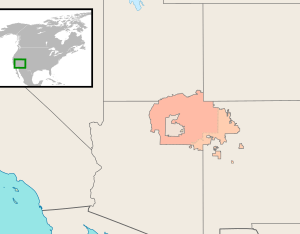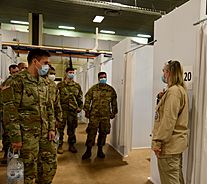COVID-19 pandemic in the Navajo Nation facts for kids
 |
|
| Disease | COVID-19 |
|---|---|
| Virus strain | SARS-CoV-2 |
| Location | Navajo Nation, United States |
| Arrival date | March 17, 2020 |
| Confirmed cases | 31,571 (as of August 6, 2021[update]) |
| Recovered | 29,969 (as of August 6, 2021[update]) |
|
Deaths
|
1,377 (as of August 6, 2021[update]) |
The COVID-19 pandemic reached the Navajo Nation in the United States on March 17, 2020. The virus quickly spread across the Navajo Nation. At one point, the Navajo people had more infections per person than any U.S. state.
The Navajo Nation had a population of about 173,667 people in 2010. By August 6, 2021, there were 31,571 confirmed cases and 1,377 deaths.
A report from June 2020 explained why the infection rate was so high. It pointed to issues like not enough good healthcare, poverty, and how communities interacted.
Contents
- Timeline of the Pandemic
- 2020
- February: Getting Ready
- March: First Cases and Lockdowns
- April: More Rules and Help
- May: High Infection Rates
- June: Continued Spread
- July: Recoveries and Extensions
- August: Reopening Plans
- September: Stay-at-Home Order Returns
- October: Testing Efforts
- November: New Restrictions
- December: Vaccines Arrive
- 2021
- 2020
- Impact of the Pandemic
- Resources and Support
Timeline of the Pandemic
2020
February: Getting Ready
On February 27, the Navajo Nation created a special team. This team worked to prepare for the virus and share information. It included officials from both Navajo and U.S. federal government groups. At this time, a health official said the risk of getting COVID-19 was "low."
March: First Cases and Lockdowns
On March 2, a health director for the Navajo Nation also said the risk was low.
On March 15, a special fund was started to help Navajo and Hopi families. It helped elders, struggling families, and people with weak immune systems. This fund later received a lot of support from Irish citizens. They remembered how the Choctaw Nation helped Ireland during a famine in 1847.
The Navajo Nation covers parts of Arizona, Utah, and New Mexico. Arizona's governor ordered all schools to close on March 16.
Navajo casinos also closed temporarily starting March 17.
The first case on the Navajo Nation was reported on March 17. It was a 46-year-old person from Chilchinbito, Arizona. Many early cases were linked to a church event held on March 7.
On March 18, a nearby county declared a state of emergency. Jail visits were also stopped.
On March 20, President Jonathan Nez ordered everyone on the Navajo Nation to stay home. This happened after 14 cases were confirmed. A curfew was put in place from 8 p.m. to 5 a.m. Breaking the curfew could lead to fines or jail time.
Other places also took action. Gyms, theaters, and bars closed in affected counties. Restaurants could only offer take-out. The Arizona National Guard was called to help.
On March 23, Diné College started offering all its classes online.
Arizona's governor ordered a stay-at-home order for all non-essential activities starting March 31. Schools also closed for the rest of the school year.
April: More Rules and Help

On April 4, more businesses like barber shops and salons had to close. Hiking trails were also closed. Navajo Nation Police started giving fines for breaking curfew.
On April 7, a man was arrested for making false and harmful claims on Facebook. He said Navajo people were all infected and called for violence against them.
Starting April 10, a long 57-hour weekend curfew was put in place. At that time, there were 698 confirmed cases and 24 deaths on the Navajo Nation.
By April 15, nine Navajo police officers had tested positive for COVID-19.
By April 18, there were 1,197 cases. On April 19, the Navajo Department of Health ordered everyone to wear masks when outside their homes. By April 20, the Navajo Nation had the third-highest infection rate in the U.S.
On April 25, the Navajo Nation joined other tribes in a lawsuit. They felt they didn't get a fair share of money from a special government plan called the Coronavirus Aid, Relief, and Economic Security Act (CARES Act). On May 5, the Navajo Nation received $600 million in aid.
May: High Infection Rates
On May 14, there were 3,632 confirmed cases and 127 deaths on the Navajo Nation.
By May 18, the Navajo Nation had the highest number of cases per person in the U.S. This meant more people were sick compared to the total population than anywhere else. There were 4,071 positive tests and 142 deaths.
Navajo police issued nearly 1,000 curfew tickets by the end of Memorial Day weekend.
A company received a large contract to provide face masks to Navajo Nation hospitals. However, over 25% of the masks were not suitable for medical use. Another 15% were the wrong type. This led to calls for an investigation.
June: Continued Spread
On June 1, the Navajo Nation reported 5,479 cases and 248 deaths.
By June 11, the Navajo Nation still had the highest infection rate per person in the United States.
On June 18, a jail in Navajo County reported three inmates had the disease.
July: Recoveries and Extensions
On July 19, there were 8,593 positive cases and 422 deaths. About 6,360 people had recovered.
On July 22, the state of emergency was extended until August 16, 2020. Government offices on the Navajo Nation remained closed during this time.
August: Reopening Plans
On August 13, the Navajo Department of Health created a reopening plan. This plan helped businesses slowly open again. The Navajo Nation was in "Orange Status," meaning most businesses could open at 25% capacity.
By August 14, there were 9,394 positive cases and 478 deaths. Nearly 7,000 people had recovered.
September: Stay-at-Home Order Returns
On September 22, the Navajo Department of Health brought back the Stay at Home order. A 57-hour weekend lockdown was also put in place from September 25 to September 28. This was to limit people's movement.
October: Testing Efforts
As of October 13, there were 10,728 positive cases and 571 deaths. About 7,343 people had recovered. Over 112,648 tests had been given, which is more than half of the Navajo Nation's population.
November: New Restrictions
On November 13, the Navajo Department of Health issued another Stay at Home order for three weeks. This was because cases were increasing and spreading in many communities. Roads on the Navajo Nation were closed to visitors and tourists.
By November 20, there were 14,441 positive cases, 623 deaths, and 8,045 recoveries.
December: Vaccines Arrive
By December 7, there were 17,915 positive cases and 667 deaths. The lockdown was extended for another three weeks because hospitals were getting full.
By December 12, cases reached 19,420, with 719 deaths and 10,359 recoveries.
On December 14, the Navajo Nation received its first doses of the Pfizer COVID-19 vaccine.
2021
January: Second Wave
The second wave of COVID-19 brought many more daily cases than the first wave. From mid-November to mid-January, the number of new cases each day was higher than during the first peak in May.
On January 25, the Navajo Department of Health said that 53 communities had an "uncontrolled spread" of the virus. This led to extending stay-at-home orders, daily curfews, and limits on business hours. Gatherings with people from outside one's home were also restricted.
On January 28, the total number of COVID-19 deaths passed 1,000.
February: Continued Monitoring
By February 22, there were 29,551 positive cases, 1,145 deaths, and nearly 16,000 recoveries. Over 242,000 COVID-19 tests had been given. The health department still identified 21 communities with uncontrolled spread.
March: Easing Restrictions and Aid
On March 11, the Navajo Nation announced it was easing COVID-19 rules as case numbers dropped. They moved from "red status" to "orange status" on March 15.
On March 12, a new U.S. law called the American Rescue Plan was signed. It gave Native American Tribes $31 billion to spend. The Navajo Nation suggested how to divide this money.
By March 22, about 191,000 vaccine doses had been given, and 76,571 people were fully vaccinated. For the first time in over six months, no new cases or deaths were reported on one day. However, precautions like wearing masks and physical distancing were still in place.
April: High Vaccination Rates
By April 1, over half of the Navajo Nation's population (88,891 out of about 174,000) was fully vaccinated. New cases and deaths were still happening, and the lockdown and curfew remained. Vaccines were available for everyone over age 16.
On April 18, a full week passed with no new deaths reported.
August: Cases Rise Again
By August 4, the Navajo Department of Health had given 252,276 vaccine doses, with 121,045 people fully vaccinated. However, the average number of new cases per day had increased a lot. It went from 4.2 cases per day in late June to 43 cases per day by early August.
The daily curfew was lifted on August 6, but masks were still required. Staying home safely was still recommended.
Impact of the Pandemic
Businesses
The Navajo Nation Gaming Enterprise said its casinos would stay closed for a long time. They were closed through June 7, and then the closure was extended through July 5.
Voting
The pandemic affected voting. One county reduced the number of places where people could vote. Translators were only available at a few locations. While more people voted by mail, not all Navajo voters had mail delivery at home. Also, instructions for mail-in ballots were not offered in the Navajo language.
Resources and Support
Coconino County, Arizona set up a free Wi-Fi hotspot in Page, Arizona. People could use it from their cars without a password.
Northern Arizona University (NAU) also extended free Wi-Fi signals to parking lots on the Navajo Nation. This helped college and K-12 students.
Coconino County offered help with rent and utility bills for families who qualified based on their income. This included help with electric, gas, water, and rent payments.
The Navajo Nation has 13 grocery stores, 12 health facilities, and many hospital beds. It also has intensive care unit beds and ventilators to help sick patients.



